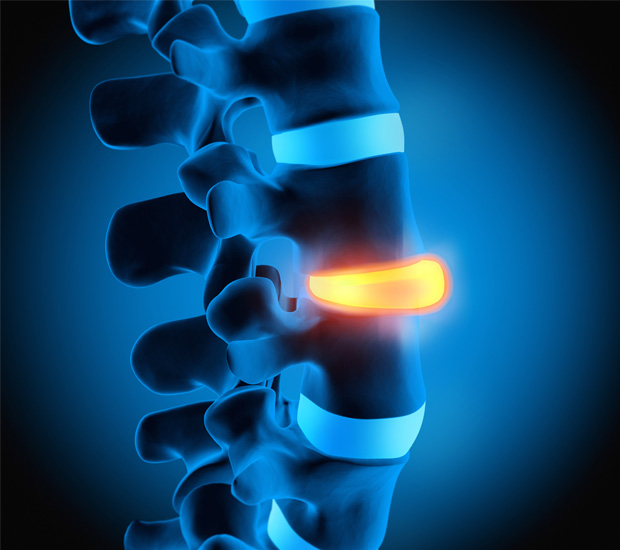Bulging Disc TherapyNapa, CA
Someone suffering from back/neck pain, numbness, or weakness in the arm or leg, may have a bulging disc. A bulging disc is when part of the substance that makes up the disc’s center gets pushed toward the spinal canal. This condition may not lead to any pain, or it can bulge into a spinal nerve, causing significant discomfort and affecting a person’s ability to walk.
Bugling discs can happen in any part of the spine but are more common in the lower back or the neck. Bulging disc therapy is available at Victory Spine Center in Napa and the surrounding area. Call us at 707-673-9509 to learn more or schedule an appointment.
Understanding Bulging Discs
Intervertebral discs are flat, round cushions that sit between vertebrae, acting as shock absorbers and spacers for the spine. These discs are under constant pressure to allow people to move their bodies from place to place. They consist of a soft, gel-like center surrounded by an outer ring. Bulging discs, also known as herniated or slipped discs, occur when a disc protrudes from its natural place between the spinal vertebra.
When the outer covering of the ring bulges out, it may put pressure on the nerve roots. This can cause lower back pain and discomfort in the patient’s legs. Other symptoms of bulging discs include pain in the feet and buttocks, numbness, tingling, and weakness. Some patients may also find that sitting down is more painful than standing and experience sharp pain when they sneeze or cough.
Check out what others are saying about our Bulging Disc Therapy services on Yelp: Bulging Disc Therapy Napa
Causes and Risk Factors of Bulging Discs
There are several reasons why a bulging or herniated disc occurs. It is often attributed to disc degeneration, which is the gradual and age-related wear and tear of intervertebral discs. As people age, the gel in the disc naturally wears away, causing the disc to compress and bulge. Other causes may include:
- Being overweight
- Living a sedentary lifestyle with little to no exercise
- Repetitive movements from physical activity or heavy lifting
- Smoking, as it may reduce oxygen to the disc and accelerate disc degeneration
- Spinal injuries from traumatic events, such as a car accident
A bulging disc is a common condition. People between the ages of 30 and 50 are most likely to get a bulging or herniated disc. In addition, statistics show that men are also twice as likely to experience this condition than women.
Diagnosing Bulging Discs
A chiropractor can use a variety of exams, imaging, and testing to help diagnose a bulging disc. First, a physical exam will be conducted. The chiropractor will check the patient’s entire spine and neck for areas of pain. The patient may also be asked to lie flat on their back and move their legs into various positions to help determine the source of the pain. Additional exams may also be used to test the patient’s reflexes, muscle strength, and ability to feel specific sensations.
An X-ray cannot detect a bulging disc. However, it can rule out other causes of back pain. An MRI can be used to confirm the location of the bulging disc and show which nerves are being affected. In addition, the practitioner may also do a myelography test. This procedure involves injecting a liquid dye into the spinal column before conducting X-rays and a CT scan to provide images of indentations of the spinal fluid sac. These indentations can be the result of bulging discs or bone spurs pressing on the spinal cord and nerves.
Bulging Disc Therapy
No treatment plan is one size fits all. Once a patient has a proper diagnosis of a bulging or herniated disc, our team at Victory Spine Center can design a customized treatment plan for them. The plan will include the patient’s pain level, physical activity, and overall health. Some patients may need a combination of chiropractic therapies and treatment methods to effectively treat their bulging disc problem.
The most common chiropractic treatment for bulging discs is non-surgical spinal decompression. Non-surgical spinal decompression is where the chiropractor gently stretches the spine to help ease the bulging disc into its natural position. It helps eliminate nerve compression, restore flexibility, and reduce pain. This technique can be manually done through cables and pulley systems or a motorized traction table.
What to Expect and Aftercare
When a patient receives a spinal decompression treatment, they will lie on a table fully clothed, faced up or down. The patient will be strapped to the table with a harness to keep them secure. The upper part of the table does not move as the lower part does, creating tension as it moves back and forth. While this process is not painful, patients will feel the stretch. During the automated sessions, our team closely monitors and controls the table to ensure patient comfort and safety.
Spinal decompression sessions can last between 20 and 45 minutes. A chiropractor may recommend multiple sessions depending on the severity of the bulging disc and the patient’s pain levels. Full recovery may take three months to a year. The chiropractor may also recommend ways to prevent future bulging disc problems, such as an appropriate exercise program and implementing good posture and lifting techniques.
Learn More Today
If you struggle with lower back or back pain, you may need bulging disc therapy. Chiropractic treatment for a bulging disc is non-invasive and long-lasting. Our Victory Spine Center team can help diagnose the problem and create a specialized treatment plan to get you back to your daily routine without discomfort. Call our office at 707-673-9509 to schedule an appointment.
Frequently Asked Questions
What is the difference between a bulging and herniated disc?
A bulging disc looks like a flattened tire. It droops and sags, looking like it spreads outward. In comparison, a herniated disc means that the disc's outer covering is punctured or torn. This damage causes the jelly-like center – nucleus pulpous – to leak into the spinal canal. Bulging discs are often the precursor of herniated discs.
Do bulging discs hurt?
Bulging discs often do not cause pain. Many people do not know they have a bulging disc until it begins to press against the spinal nerve. When the pain interferes with your daily activities, it is time to seek medical treatment.
Can I treat a bulging disc at home?
Yes, it is possible to treat a bulging disc at home. Ice and heat therapy can help reduce inflammation and help the back muscles relax. You can also take over-the-counter pain medication to help manage the pain. However, if your symptoms do not get better after four to six weeks, visit Victory Spine Center for diagnosis and treatment.
How long does it take for a bulging disc to heal?
The healing process varies from person to person. It often takes several chiropractic visits to feel consistent pain relief. It depends on the severity of the bulging disc and may take several weeks to months, if not longer.
How can I prevent bulging discs?
Preventing a bulging disc may not be possible. Intervertebral disc gel naturally degrades as people age. However, you may be able to prevent a bulging disc from worsening, such as staying active to strengthen muscles around the spine and stretching when you sit for long periods of time.





